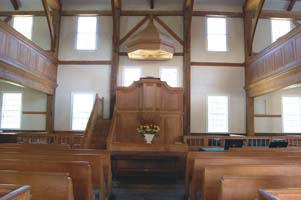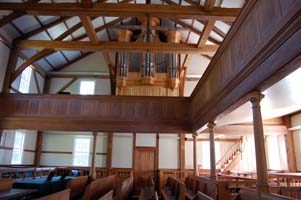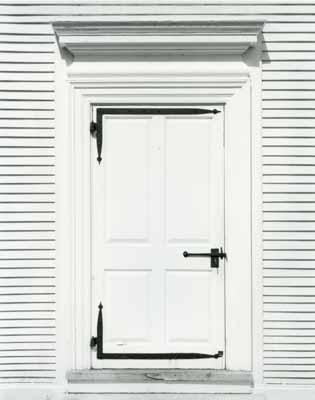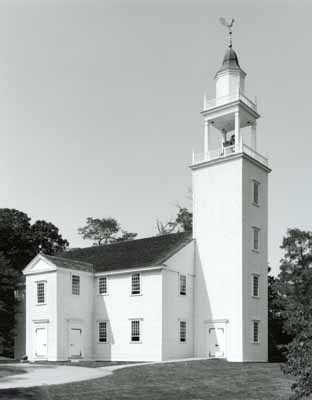| ← back |
Colonial Meetinghouses Featured in this Project |
next → |
 Name of Meetinghouse: West Parish Meetinghouse
Name of Meetinghouse: West Parish Meetinghouse
View on a mapStreet Address of Meetinghouse: 2049 Meetinghouse Way, West Barnstable, MAYear(s) Built: 1717 National Register of Historic Places Designation: Yes (Included as part of The Meetinghouse Way Historic District) Massachusetts State Register of Historic Places: Yes Organization responsible: 1717 Meetinghouse Foundation, Inc. Organization's address: PO Box 781, West Barnstable, MA 02668 Organization's web site: 1717meetinghouse.org Church web site: westparish.org Note: the meetinghouse is owned by West Parish of Barnstable, a UCC Congregation, while the 1717 Meetinghouse Foundation is responsible for its care and maintenance. Town Information: Town of Barnstable, Massachusetts Tax status: 501 (C)(3) - tax exempt Contact: Fred Clausen, Sexton, PO Box 781, West Barnstable, MA 02668 Church Telephone: (508) 362-8624 E-mail: clerk@1717meetinghouse.org This page was last modified on: 16 Apr 2014 Acknowledgements: The following text has been taken from the pamphlet The History of West Parish, published by the West Parish Memorial Foundation, Inc., and has been used by permission.The Town of Barnstable, Massachusetts, was founded in 1639 by the Rev. John Lothrop and 22 families from Southwark, London. Being Congregationalists, they were forbidden from worshiping in England, and were severely persecuted before they left for America. 
By 1715, the town had grown such that the parishes split into East and West. In 1717, construction of the West Parish Meetinghouse began with the felling of nearby great oaks and pines. The Meetinghouse was consecrated in 1719, and thus became the first permanent home of the Congregationalists who had first gathered 103 years earlier in England. For the next 130 years, the Meetinghouse would also host Barnstable town meetings, and, for a time, the village public school. Only 4 years after its completion, though, the Meetinghouse proved too small for its growing congregation and for its secular purposes. Rather than replace the structure, parishioners cut the Meetinghouse in half, pulled the north end away, extended the side outwards, and added 18 feet in the middle. (This was a common way of enlarging a timber framed building in the 18th century, since less effort would be needed to fill in the center rather than to rebuild an end wall.) At that time they built a bell tower, and in 1723 ordered from England the gilded weathervane cock that still crowns the Meetinghouse. 
In 1806, Paul Revere & Son in Boston, commissioned by the bequest of Col. James Otis, father of "The Patriot" James Otis whom John Adams called the "real father and founder of the American empire" cast the half-ton bell that still summons worshipers. By 1849, public support of the Meetinghouse ended. It gradually ceased being the scene of town meetings, which had sometimes grown so stormy that interior repairs had been required. Then in 1852, the worn Meetinghouse was remodeled into the neoclassical style characteristic of the mid-19th century. Gone were the pulpit, the galleries, the "sheep pen" box pews, and the old bell tower. The gilded rooster now perched on a smaller spire that housed the Revere bell. The colonial Meetinghouse had apparently vanished, and there stood in its stead a charming but conventional New England church. Beneath it all, though, remained intact the original structure: frame, wide-pine floors, thick vertical-boarding walls, and roof. Most of the original lath and plaster were also intact. The congregation was too poor to build a new structure, as was done elsewhere on Cape Cod. Additionally, parishioners had "feelings for the ancient house." 
Another century passed. Then, in 1953, inspired by Elizabeth Crocker Jenkins, the West Parish Memorial Foundation, Inc. formed to restore the Meetinghouse to its splendid colonial austerity. Stripped of its 1852 plastered walls and ceiling, and exterior sheathing, the Meetinghouse suggested its original form. Scars, markings, and mortice holes indicated original locations and measurements of the high pulpit and sounding board, galleries, stairs, and pews described in old records. The 18-foot addition of 1723 was removed. Original paneling, window frames, and other components auctioned off in 1852 and incorporated into Barnstable houses, were located and either restored or copied. The 1717 Meetinghouse had been resurrected. 
Although it stands as an early New England meetinghouse, the 1717 West Parish Meetinghouse is not a museum. It evolves, though in keeping with its 18th century heritage. The Meetinghouse is a memorial to the devotion of those who built it, and a testimony to the faithfulness of those who have cared for it through the centuries. It stands as witness to the life of the men, women, and children who are members and friends of the unbroken line of the congregation that formed in London in 1616, and who worship in it to this day. The West Parish Memorial Pipe Organ:Puritans would have lined out psalms with a cantor, with no musical instrumentation. Eventually, though, the "King of Instruments" made its way into the meetinghouses and church sanctuaries of early America. In the 19th century, the West Parish congregation worshiped with a reed organ providing accompaniment for hymns. The organ would have been pumped with air, much like an accordion. 
The second organ in the Meetinghouse, installed in 1907, was built by the M. P. Moller Company of Hagerstown, Maryland. During the 1950s restoration of the Meetinghouse, another pipe organ replaced the Moller organ. It served the Meetinghouse for almost 50 years, from 1957 to 2004. It was replaced in 2005 by a superb "tracker" pipe organ built and installed, appropriately enough, by a company from London, the Mander Organ Company. Built in the style of mid-18th century mechanical-action pipe organs, it serves not only for hymn accompaniment, but also for the recitals and concerts sponsored by the Foundation for the public. Editor's note: During one of my visits to photograph the West Parish Church, I was treated to a most wonderful organ rehearsal for a concert that was to be given later that day. |

|

|